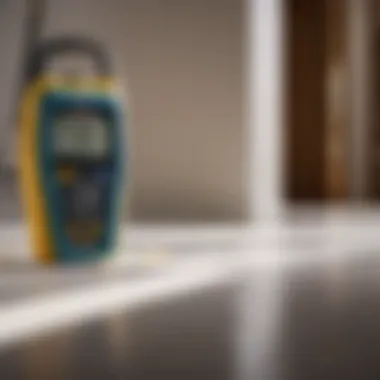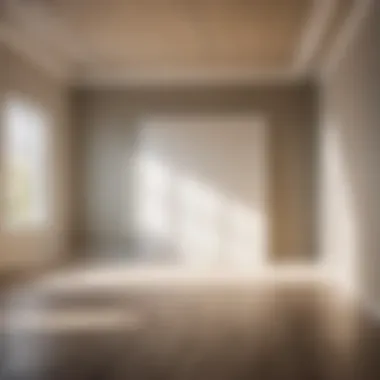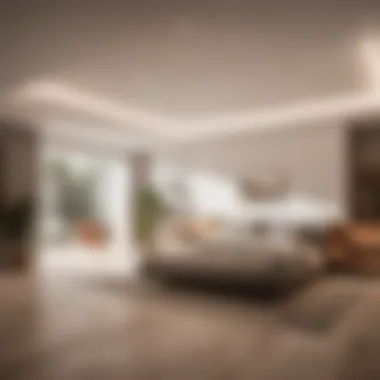Unlocking the Secrets of 4x8 Drywall Square Footage Calculation and Optimization


Materials:
- 4x8 drywall sheets: Purchase high-quality drywall sheets measuring 4x8 feet for efficient coverage of your project area. Ensure the correct quantity based on your square footage needs.
- Drywall screws: Select appropriate drywall screws to securely fasten the drywall sheets to your walls or ceiling. Avoid using screws that are too long, as they may damage the drywall surface.
- Joint compound: Acquire joint compound of your choice for finishing seams and joints between drywall sheets. Opt for a quick-drying formula for faster project completion.
- Drywall tape: Invest in fiberglass or paper drywall tape to reinforce and strengthen joints before applying joint compound.
- Sandpaper: Have sandpaper on hand to smooth out any rough edges or imperfections on the drywall surface. Choose varying grits for different stages of finishing.
- Utility knife: Use a sharp utility knife for cutting drywall sheets to size and making precise adjustments as needed. Replace the blades regularly for clean cuts.
- T-square: Utilize a T-square to ensure accurate cutting of drywall sheets and maintain straight edges for a professional finish.
- Drill/driver: Employ a drill/driver for quickly and efficiently installing drywall screws without manual effort. Opt for a cordless model for increased mobility during the project.
- Measuring tape: Keep a measuring tape handy to take precise measurements of your project area and cut drywall sheets to the required dimensions.
- Dust mask and safety glasses: Prioritize safety by wearing a dust mask and safety glasses to protect yourself from inhaling dust particles or eye injuries while working with drywall.
DIY Steps:
- Measure and plan: Begin by measuring the square footage of the area where you intend to install drywall. Calculate the number of sheets required based on the 4x8 dimensions. Plan the layout to minimize cutting and waste.
- Cutting and securing drywall: Use a utility knife and T-square to cut the drywall sheets to fit the designated spaces accurately. Secure the drywall to the studs or ceiling joists using drywall screws at recommended intervals.
- Seaming and taping: Apply drywall tape over the joints between sheets and cover with joint compound using a taping knife. Smooth out excess compound and let it dry before sanding.
- Finishing and sanding: Apply additional layers of joint compound as needed to fill in gaps and imperfections. Sand the dried compound smooth for a seamless finish.
Technical Aspects:
- Timing specifics: Allocate sufficient time for each stage of the project, including cutting, installation, taping, and finishing. Consider drying times for joint compound before sanding.
- Tools: Ensure you have all necessary tools on hand before starting the project to avoid interruptions. Double-check measurements and cuts to prevent errors during installation.
- Critical techniques: Master the art of mudding and taping for seamless joints between drywall sheets. Use the right amount of joint compound and feather out edges for a professional look.
DIY Project Process:


- Installation method: Follow a systematic approach to installing drywall, starting from one corner and working your way across the area. Secure the drywall sheets tightly to prevent sagging or loosening over time.
- Troubleshooting Tips: In case of uneven seams or protruding screw heads, use additional joint compound to level the surface before sanding. Address any bulges or bubbles in the drywall tape promptly to prevent future issues.
- Enjoying the result: Step back and admire your newly installed drywall, appreciating the transformation it has brought to your space. Consider painting or decorating the surface to further enhance its visual appeal.
Understanding 4x8 Drywall


What is 4x8 Drywall?
4x8 drywall, also known as gypsum board or sheetrock, is a standardized building material measuring 4 feet in width and 8 feet in length. This ubiquitous construction component consists of a core of gypsum plaster sandwiched between layers of tough paper, providing structural integrity and fire resistance. Commonly available in varying thicknesses, 4x8 drywall offers a convenient solution for interior wall and ceiling applications.
Key Features of 4x8 Drywall
Material Composition
The material composition of 4x8 drywall consists of gypsum, a mineral known for its fire-resistant properties and sound-dampening qualities. The outer paper layers provide durability and a smooth surface for finishing treatments such as painting or wallpapering. This composition makes 4x8 drywall a preferred choice for interior wall construction due to its ease of installation and cost-effectiveness. However, it is essential to handle gypsum board with care to prevent damage and ensure structural integrity.
Thickness Options
Thickness options for 4x8 drywall typically range from 1/4 inch to 5/8 inch, with each thickness serving specific purposes based on the intended application. Thinner sheets are ideal for curved surfaces and repairs, while thicker sheets offer enhanced sound insulation and impact resistance. Selecting the appropriate thickness is crucial to achieving the desired level of durability and performance in construction projects, making it essential to consider the structural requirements and environmental factors when choosing the right thickness option.
Variants
4x8 drywall is available in various variants to cater to different project needs. Moisture-resistant drywall, commonly used in bathrooms and kitchens, features special coatings that prevent water damage and mold growth. Fire-resistant drywall contains additives that increase its fire-retardant properties, making it suitable for areas requiring enhanced fire protection. By understanding the different variants of 4x8 drywall and their unique properties, builders can select the most appropriate type for specific applications, ensuring long-lasting and functional results.
Common Uses of 4x8 Drywall
The versatile nature of 4x8 drywall enables its widespread use in residential and commercial construction projects. Common applications include creating interior walls, ceilings, and partitions that require a durable, smooth surface for painting or texturing. Additionally, 4x8 drywall is utilized in soundproofing and thermal insulation projects, enhancing the comfort and efficiency of indoor spaces. Understanding the diverse applications of 4x8 drywall empowers homeowners and contractors to utilize this flexible building material effectively in various renovation and construction endeavors.
Calculating 4x8 Drywall Square Footage


Calculating 4x8 drywall square footage is a crucial aspect that forms the bedrock of any successful construction or renovation project. In this section, we delve deep into the intricate process of determining the precise square footage of 4x8 drywall. By focusing on the formula, considerations for accurate measurement, and essential tools, readers will grasp the significance of efficient calculation methods.
Formula for Calculating Square Footage
When calculating the square footage of 4x8 drywall, the formula is straightforward yet fundamental. To find the area, simply multiply the length by the width of the surface in question. This simple equation ensures an accurate estimation of the amount of drywall required for a specific area, streamlining the planning and execution phases of a project.
Considerations for Accurate Measurement
Accounting for Doors and Windows
One crucial consideration when measuring 4x8 drywall square footage is accounting for doors and windows within the space. By accurately subtracting the area occupied by these features, precise measurements can be obtained, preventing overestimation and unnecessary wastage of materials. Accounting for doors and windows is essential in optimizing resource allocation and ensuring cost-effectiveness in drywall installation.
Dealing with Obstacles
In the realm of 4x8 drywall measurement, obstacles pose a common challenge that demands careful handling. Dealing with obstacles such as protrusions or irregular wall shapes requires strategic planning and precise measurement techniques. By overcoming these obstacles methodically, construction or renovation projects can proceed smoothly without delays or inaccuracies, maintaining the integrity and efficiency of the overall process.
Tools for Measuring Square Footage
Utilizing the right tools for measuring 4x8 drywall square footage is instrumental in achieving accuracy and efficiency. Tools such as tape measures, laser levels, and digital apps offer precise measurements and streamline the calculation process. By leveraging these tools effectively, construction professionals and DIY enthusiasts can enhance productivity and ensure optimal resource utilization in their projects.
Optimizing 4x8 Drywall Usage
As we delve into the realm of optimizing 4x8 drywall usage, it becomes evident that this section plays a crucial role in ensuring efficiency and maximizing the benefits of using 4x8 drywall. By strategically planning how to utilize this standard size of drywall effectively, individuals can streamline their construction or renovation projects and minimize material wastage. This section aims to provide insights into various elements that contribute to optimizing 4x8 drywall usage, thereby enhancing the overall outcome of the project.
Maximizing Square Footage Efficiency
Strategic Layout Planning
Strategic layout planning entails carefully organizing and positioning 4x8 drywall panels to make the most efficient use of space. By strategically placing the panels in a manner that minimizes cutting and reduces leftover scraps, individuals can optimize the square footage coverage and enhance the aesthetics of the space. This process involves analyzing the dimensions of the area to be covered, identifying potential obstacles such as doors and windows, and creating a layout plan that maximizes coverage while minimizing waste.
Strategic layout planning is essential for achieving a harmonious and seamless finish in projects involving 4x8 drywall. By strategically positioning the panels, individuals can minimize the number of cuts required, save on labor costs, and expedite the installation process. Moreover, a well-thought-out layout plan ensures that the final result is visually appealing and structurally sound, showcasing the precise utilization of 4x8 drywall.
Minimizing Waste
Minimizing waste is a key aspect of optimizing 4x8 drywall usage, as it promotes sustainability and cost-effectiveness in construction projects. By minimizing the amount of unused material and scraps generated during installation, individuals can reduce both environmental impact and project expenses. This section delves into various strategies for minimizing waste when working with 4x8 drywall, including efficient cutting techniques, accurate measurements, and proper handling of leftover pieces.
Effective waste minimization not only benefits the environment but also enhances the efficiency of the project by reducing clutter and optimizing workspace organization. By adopting practices that prioritize waste reduction, individuals can elevate the sustainability profile of their projects and contribute to a more eco-conscious approach to construction and renovation.
Creative Design Ideas for 4x8 Drywall
Textured Finishes
Textured finishes offer a versatile and visually interesting option for enhancing the aesthetic appeal of 4x8 drywall surfaces. By incorporating textured finishes, individuals can add depth, character, and tactile interest to their walls, transforming them from mere dividers to engaging design elements. This section explores the various textures available for 4x8 drywall, their application techniques, and the unique advantages they bring to interior spaces.
Textured finishes not only serve an aesthetic purpose but also offer practical benefits such as enhanced durability, sound absorption, and camouflage of imperfections. By choosing the right textured finish for a specific space, individuals can customize the atmosphere and ambiance, creating a personalized and distinctive environment that suits their preferences and style.
Multi-Functional Surfaces
Multi-functional surfaces present an innovative approach to maximizing the utility of 4x8 drywall beyond its traditional role as a wall material. By integrating multi-functional features such as built-in shelving, hidden storage, or interactive panels, individuals can optimize space usage and enhance the functionality of their interiors. This section delves into creative design ideas that transform 4x8 drywall into dynamic, multi-purpose elements that cater to diverse needs and preferences.
Multi-functional surfaces revolutionize the concept of drywall by turning it into a dynamic component that serves multiple functions within a space. From integrated lighting solutions to fold-down desks, these design ideas showcase the infinite possibilities of 4x8 drywall in creating adaptable and versatile environments that adapt to the demands of modern living.
Estimating 4x8 Drywall Needs
When embarking on a project involving 4x8 drywall, accurately estimating the quantity needed is a critical aspect that can make or break the entire endeavor. In this article, the focus on Estimating 4x8 Drywall Needs is paramount as it lays the foundation for successful planning and execution. By delving deep into this topic, readers will gain a thorough understanding of the factors that influence the quantity requirements, ensuring a seamless and efficient process.
Factors Influencing Quantity Requirements
Room Dimensions
Room dimensions play a pivotal role in determining the amount of 4x8 drywall needed for a project. The specific aspect of room dimensions impacts the overall efficiency and effectiveness of the installation process. The key characteristic of room dimensions lies in their direct correlation to the square footage to be covered by the drywall. This is a beneficial choice for the article as it elucidates how varying room sizes directly affect the quantity of drywall required. The unique feature of room dimensions is their ability to influence not only the amount of drywall needed but also the spatial aesthetics and functionality in the context of the project. Understanding the advantages and disadvantages of different room dimensions is crucial in accurate estimation and optimal utilization of 4x8 drywall resources.
Installation Method
Another crucial aspect that influences the quantity requirements of 4x8 drywall is the installation method employed. The specific aspect of the installation method significantly contributes to the overall topic by dictating the efficiency and effectiveness of the installation process. The key characteristic of the installation method is its impact on the amount of waste generated during the installation, thereby affecting the quantity of drywall needed. This aspect is a popular choice for discussion in the article as it highlights how different installation techniques can affect the overall project economics and timeline. The unique feature of the installation method lies in its adaptability to various project requirements and complexities, bringing about varied advantages and disadvantages in the context of the article.



